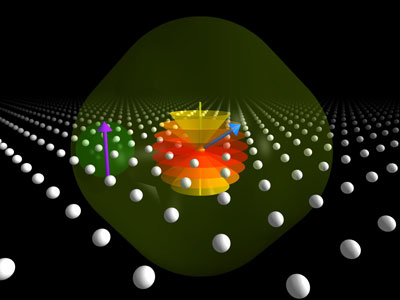| Posted: August 16, 2010 |
Silicon: an ever-improving host for quantum information |
|
(Nanowerk News) Taking full advantage of quantum mechanics would allow future computers to solve problems that would take longer than the lifetime of the universe on a normal computer. This potential motivates the field of 'quantum computing', where scientists and engineers are searching for the platform which silicon provides for the microelectronics and conventional computing of today. A UK-USA team of scientists from University College London (UCL) and the National High Magnetic Field Lab (NHMFL) in Florida has discovered a new and more efficient way to encode quantum information in silicon itself. The research is described in the journal Nature Materials ("The initialization and manipulation of quantum information stored in silicon by bismuth dopants") and in a forthcoming article in Physical Review Letters.
|
 |
| A bismuth atom in one slice of a silicon crystal. The large light green cloud shows the possible positions of the bound electron's wavefunction, and the purple arrow is its spin. The bismuth nuclear spin (blue arrow) can tilt in ten different directions, shown in red and yellow. (Artwork by Manuel Vögtli, London Centre for Nanotechnology)
|
|
Despite being compatible with the silicon chips all around us, bismuth has been overlooked to date in favour of phosphorus atoms in the race to quantum technologies because today's microelectronics exploits phosphorous dissolved in silicon. However, the researchers in London and Florida have now found that bismuth atoms outperform phosphorus atoms. Bismuth is the heaviest stable atom and has a correspondingly large nuclear "spin": its quantum spin is like a tiny compass needle that can exist in one of ten states corresponding to different tilts (see illustration) instead of the two directions available to a phosphorus nucleus. This allows bismuth nuclei to store much more quantum information than phosphorous nuclei, because the quantum state space is now ten - rather than two-dimensional.
|
|
The observations lead to the suggestion of a 'dream team' using both bismuth and phosphorus atoms in silicon: as they are different, they can be manipulated independently. The bismuth would store quantum information while the phosphorus controls the information flow.
|
|
"The experimental hurdles overcome include the use of bismuth in silicon for the preparation, control and storage of quantum information" explained lead author Gavin Morley of the London Centre for Nanotechnology (LCN) at UCL. He continued: "Bigger is better in this case because the larger nucleus of bismuth provides more room for storing quantum information."
|
|
Co-author Marshall Stoneham, also of the LCN, added "If a quantum computer could be built, it could solve some problems long regarded as impossible. Having one type of atom for storing quantum information in silicon, and another type for controlling it is like bringing a second person into a one-man conversation: much more interesting!"
|
|
Greg Boebinger, the Director of the NHMFL which hosted some of the experiments reported, commented "This result is a big incentive to use silicon for research into quantum technologies".
|

